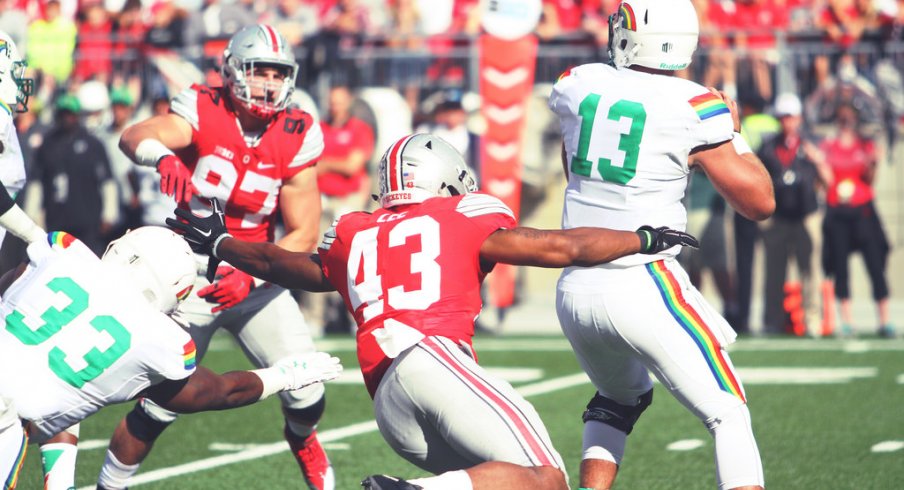Most Ohio State fans will remember Saturday's blowout of Hawaii for the ineffective play on offense.
However, while that is very much the reason for the Buckeyes' first win in Ohio Stadium of 2015, the focus has remained on the offense that still managed to put up 38 points.
Understandably, the poor play of both quarterbacks, multiple penalties, and overall poor execution of what many expected to be one of the top groups in the nation was disappointing to see. Yet, while that was happening on one side of the ball, their defensive counterparts were not-so-quietly returning to a championship level.
During their three-game postseason run leading to a national title, the Ohio State defense stood up to some of the best offenses in the country, coming away victorious often because of their ability to get stops on third downs. In those matchups with Wisconsin, Alabama, and Oregon, the Buckeye defense faced 43 third downs and allowed only 9 conversions (20.9%), a mark well below their season average (33%), and one that would've easily surpassed nation's leaders for the season (27%).
While keeping your opponents from converting third downs might seem like a pretty straightforward path to victory, it has been the most telling stat for success with Urban Meyer's Buckeye teams. After allowing Clemson to convert over half of their third downs in the 2014 Orange Bowl, the Buckeyes only surrendered a mark of over 40% to Virginia Tech, Penn State, Michigan State, and Michigan last fall.
While they only lost to the Hokies, the other three games were close until the fourth quarter (or later, in the case of PSU). In the Labor Day rematch with Virginia Tech one week ago though, the Buckeye defense yet again let their opponents hang around for three quarters thanks to their success on third downs, allowing eight of 17 opportunities to be converted.
While Hawaii didn't seem to have the talent or depth of a Power-5 opponent, their own defense certainly proved capable of playing with one of the top teams in the land. Yet even though they were led by offensive guru Norm Chow and former blue-chip prospect and USC transfer, Max Wittek, the Rainbow Warriors never found any rhythm while they had the ball.
For that the OSU defense, especially up front, deserves the credit. Sparked by the return of Joey Bosa, all seven members of the Buckeye front made plays against Wittek and Hawaii. While the Silver Bullets didn't do much different on early downs schematically, staying in their base, 4-3 defense with quarters coverage, they were able to get penetration against the run, leaving the Rainbows with an average of only 2.3 yards-per-carry for the day.
Once their opponents faced third down though, the Buckeyes really turned up the heat. With nickel-corner Damon Webb coming onto the field in place of nose tackle Tommy Schutt, OSU once again leaned on their 3-3-5 personnel to create confusion for the offense.
On nearly every one of Hawaii's 14 third downs, the Buckeyes crowded the line with all six members of their front. Linebacker Darron Lee often lined up as a defensive end, while inside linebackers Raekwon McMillan and Josh Perry regularly threatened the inside 'A' gaps on either side of the center.
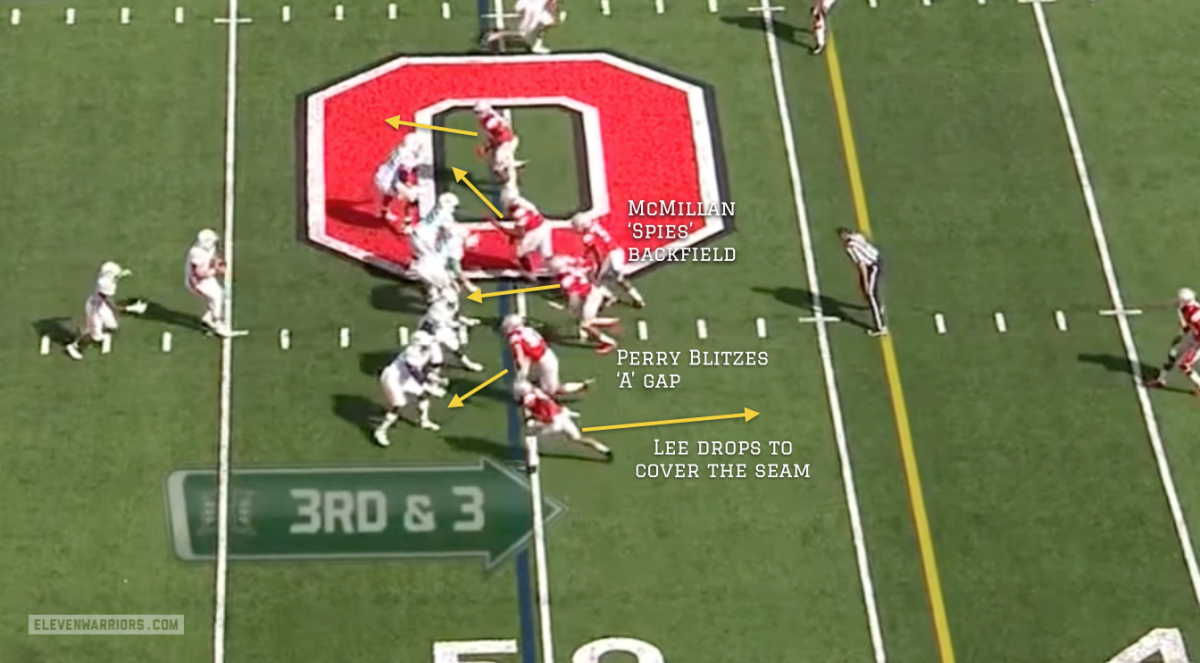
Much in the way an offense may run a combination of pass routes to stretch a defense horizontally to gain a favorable matchup, the Buckeye defensive front used this alignment to force the offense to pick their poison. College offense rarely have more than a handful of pass protection schemes to call in the huddle, and often have only one or two to call at the line if they need to make an adjustment.
With six potential rushers at the line, the Hawaii offense was forced to keep a back or tight end in to block on every occasion, limiting their adjustments even further. Against a base, 6-man protection scheme (often labeled as '60' in many playbooks), the protection is split in two halves, with the center acting as the lynchpin.
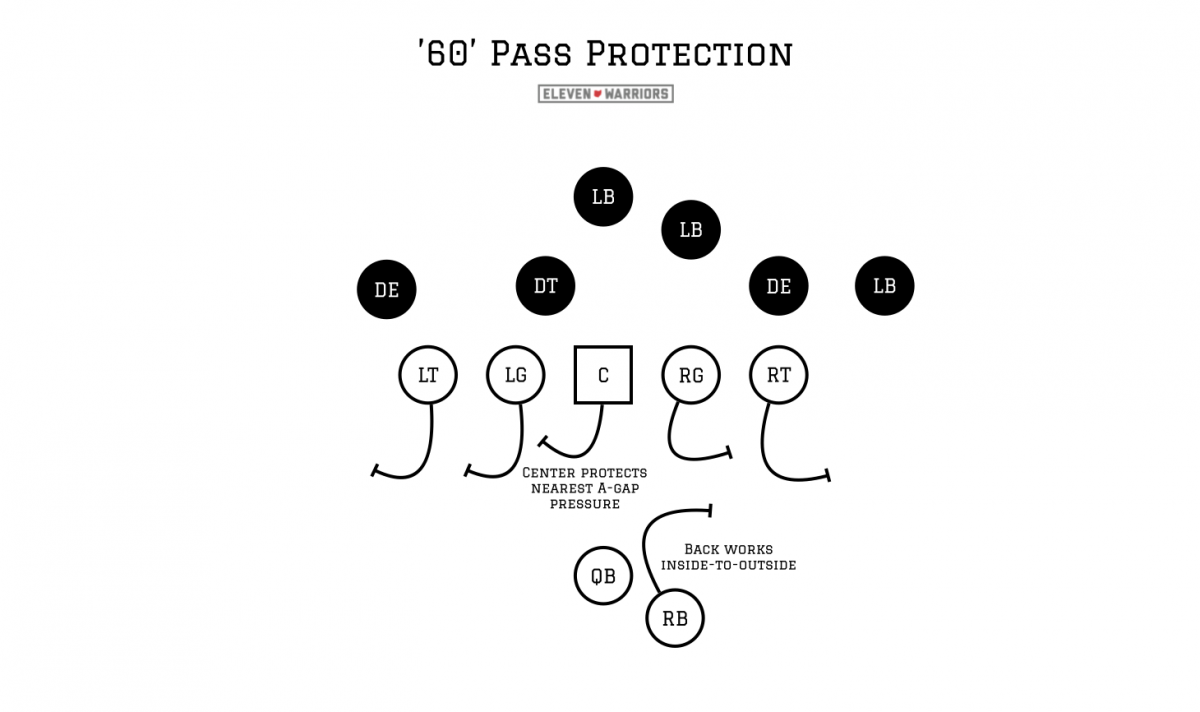
The Center will call out which side he'll help with, often checking to whichever side has a defensive tackle in the A-gap. In response, the running back will step up to take on any additional inside pressure to the other side, then working to help on the outside gaps. Yet the Buckeyes, often led by Bosa's ability to beat any opposing blocker off the ball, would blow up such pressure over and over. Bosa began by beating the right tackle, and forcing Wittek into a number of quick, inaccurate throws that ended the first four Hawaii drives.
Even when given a designed roll-out, pulling that right tackle over to the left in an effort to give Wittek more room, Bosa and the Buckeyes had no problem chasing him down and forcing a punt. The poor running back tasked with picking up Bosa has virtually no chance of keeping the star pass-rusher from getting to his QB.

With the Hawaii offensive line now focused on stopping Bosa from his spot at left end, the Buckeyes began moving the pieces around, with he and Lee lined up inside and McMillan and Lee acting as the ends. The result was no better for the offense, as Bosa blasted past the helpless guard and headed straight for Wittek.

Nearly out of answers for the swiss-army knife approach of the defense, the Rainbow Warriors called one, last adjustment. With Buckeyes twisting, stunting, showing blitz and dropping, or delaying their blitz until well after the snap, the Hawaii offense made their protection scheme as simple as possible, now making each blocker responsible for only one gap.
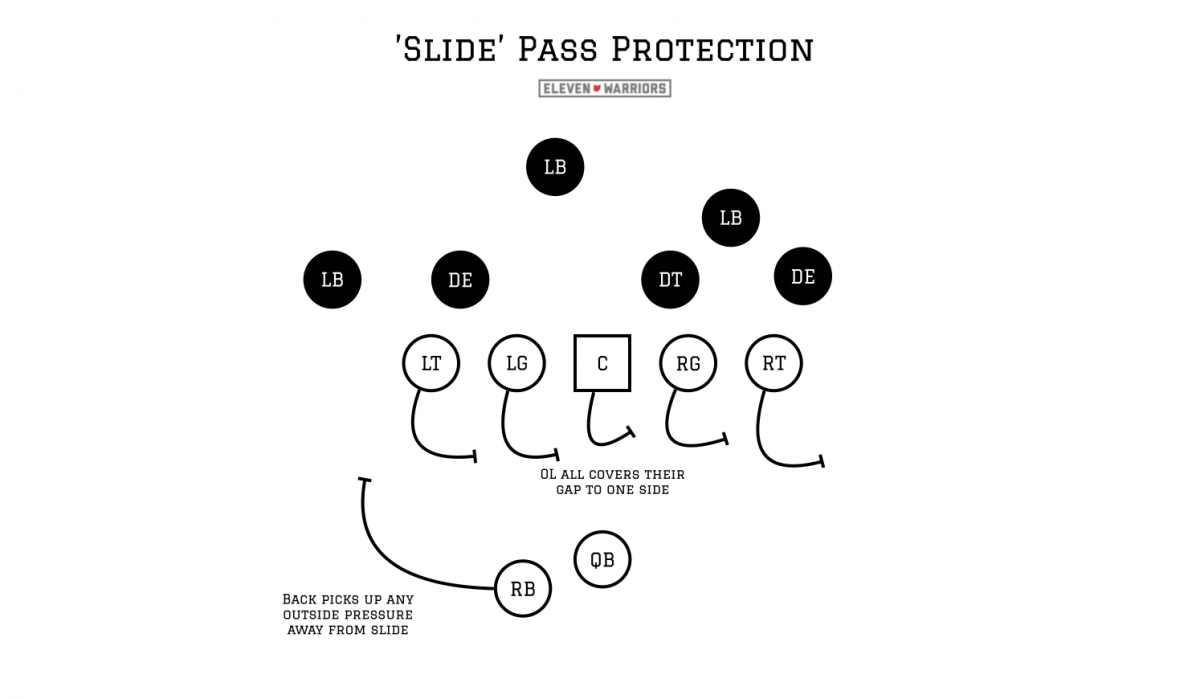
With the Buckeyes showing blitz on the right side, Hawaii calls for each lineman to step to their right, only worrying about that gap. However, with the running back also on the right, he now has to come back across the formation to pick up any pressure coming off the outside to the left.
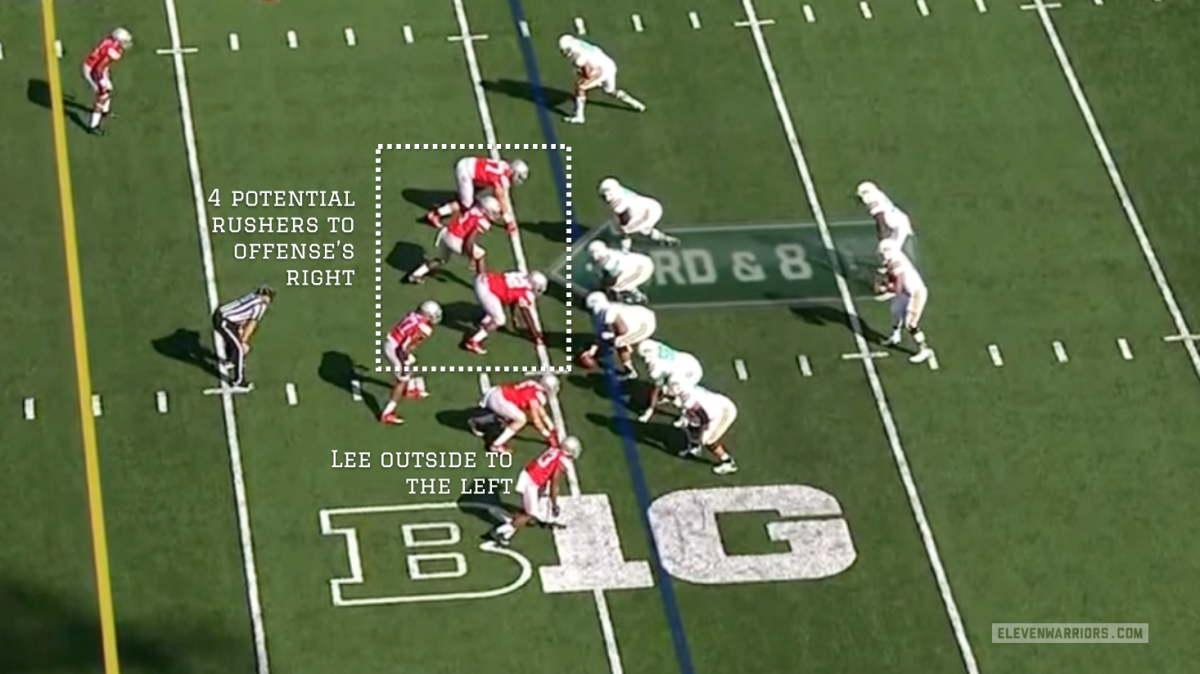
In this case, that pressure comes in the form of Darron Lee. The back has to pick up Lee in an awkward manner though, as he must first step forward to stay out of Wittek's drop before getting width.
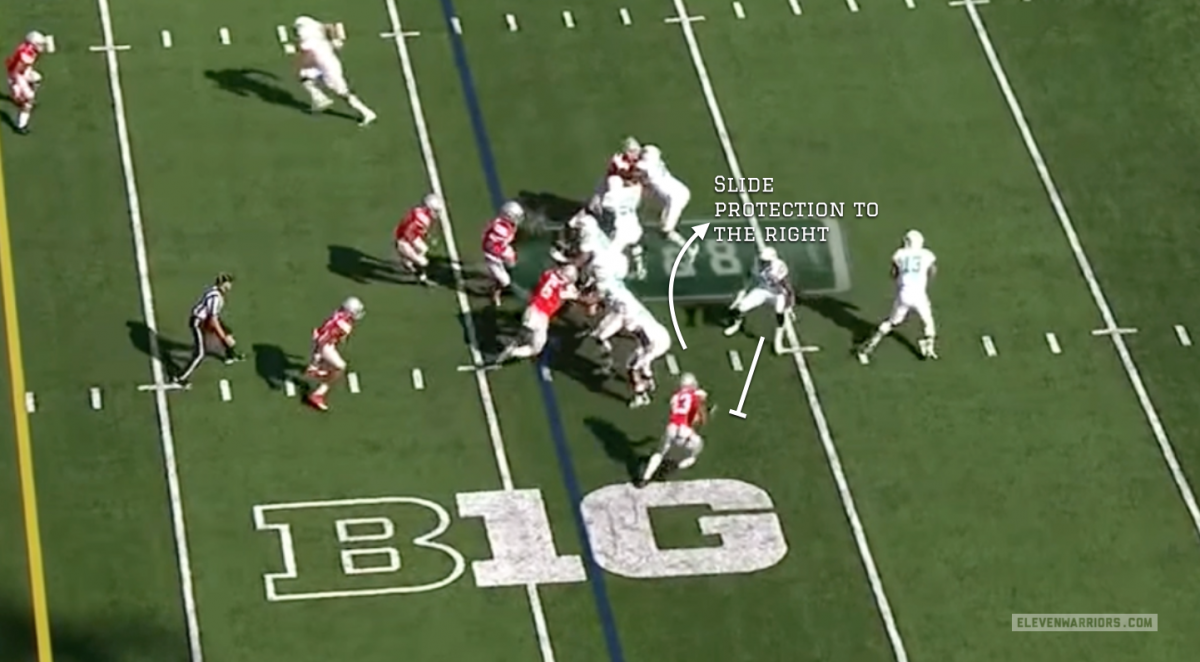
With not even as much as a chip from the left tackle, Lee explodes out of his stance, and blows right past the back before he can get any more than a hand on the linebacker.

Though the Buckeyes would only get officially credited with four sacks and one QB hurry in the stat book, their pressure forced Wittek into countless bad throws that resulted in only eight completions on 26 attempts. More importantly though, the Hawaii offense was hardly able to stay on the field as Ohio State allowed only two third down conversions on 14 attempts.
The Buckeye secondary certainly deserves credit, but their job was unquestionably made easier thanks to the efforts of the OSU pass rush. Though many defenses, especially in the NFL, try and isolate their best pass rusher on a single blocker in hopes of winning a single matchup, the Buckeyes take just the opposite tact.
Thanks to the athleticism of players like Bosa, Lee, and Perry, the Buckeye defense can show countless alignments with their front six on defense. But the coaching of Luke Fickell and Larry Johnson should also certainly be praised. The duo has not only taught the unit excellent technique, but has made it perhaps the strongest part of the number-one team in the country.
